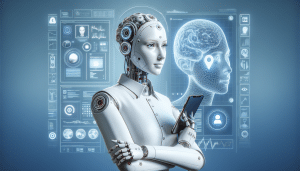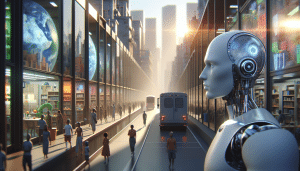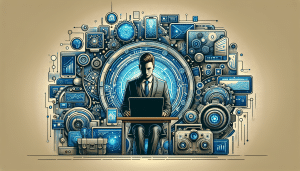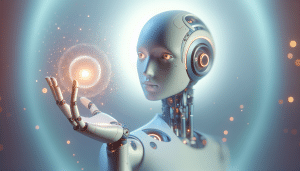Unraveling Artificial Intelligence In Everyday Life
Oliver Cooper September 13, 2025
Artificial intelligence is embedded in more aspects of daily routines than many realize. This guide explores where AI is at work, how machine learning quietly shapes our choices, and what the future may hold for intelligent automation in homes and workplaces—offering clarity on a topic filled with curiosity and opportunity.
The Evolution of Artificial Intelligence Integration
Artificial intelligence has transformed from a niche research field to one of the most influential technological advances integrated into our daily lives. It goes far beyond popular notions of robots and virtual assistants. Now, artificial intelligence powers online recommendations, processes natural language behind the scenes, and even detects fraud in real time. Major breakthroughs in deep learning and computational power have enabled AI to tackle complex real-world problems, automate mundane tasks, and unlock new forms of personal convenience and efficiency that users often take for granted. The impact of this movement is found within smart homes, phones, vehicles, and even health care systems, with AI quietly optimizing and delivering personalized experiences across digital and physical spaces.
AI drives platforms such as streaming services, social networks, and ecommerce sites that adapt to individual preferences based on vast amounts of behavioral data. Machine learning algorithms learn from every interaction, improving the personalization of recommended products, shows, or music. This data-driven customization shapes decision-making in everything from news curation to navigation routes. In logistics, AI technologies streamline supply chains, reducing delays and increasing the accuracy of deliveries. As smart sensors and edge computing become more integrated, real-time analysis by AI allows industries ranging from agriculture to energy to operate more efficiently, supporting both economic sustainability and user satisfaction.
While AI integration has grown rapidly, concerns about algorithmic transparency, ethics, and the societal impact of automation have also arisen. Organizations now recognize the importance of ethical frameworks to guide AI development and deployment. Open discussions around data privacy and fairness encourage accountability and public trust in AI systems. Global efforts, including those by academic and governmental bodies, focus on ensuring that artificial intelligence evolves in harmony with societal values (see https://www.nist.gov/artificial-intelligence), supporting innovation while minimizing potential risks.
Machine Learning Applications Powering Modern Technology
Machine learning sits at the heart of AI’s rise. By recognizing patterns and making predictions based on large datasets, machine learning models perform tasks that once required direct human programming. For example, email systems filter spam, banking platforms flag suspicious spending, and search engines provide increasingly accurate answers—all relying on constantly trained algorithms. One subtle yet transformative application is natural language processing, which allows AI to decipher spoken commands, auto-generate captions, and power translation tools. These applications help bridge communication gaps and enhance accessibility for diverse populations around the world.
In healthcare, AI-driven diagnostics leverage machine learning to analyze medical images, identify anomalies, and support early disease detection in areas such as radiology and pathology. Research has shown that these algorithms can match or even surpass expert-level performance in certain narrow specialties. Outside of medicine, financial services organizations use predictive analytics for fraud detection and investment strategy optimization. Education also benefits, as adaptive learning platforms tailor content delivery to match student needs, opening new pathways to personalized instruction and broader educational access (see https://ed.stanford.edu/news/artificial-intelligence-and-future-education).
The automotive sector demonstrates machine learning’s power vividly. Modern vehicles use AI for autonomous driving functions, obstacle recognition, and route optimization. Such progress is only possible due to immense computing resources and the accumulation of training data from real-world driving. In factories, predictive maintenance leveraging machine learning can identify failing equipment before a breakdown, limiting downtime and improving safety. These cross-industry examples illuminate how the application of machine learning is foundational in building more resilient and intelligent systems across society.
How AI Shapes Personalized Digital Experiences
Personalization has become a hallmark of the digital era, and AI is its chief architect. Online retailers analyze browsing and purchase history to suggest products, while content platforms recommend articles and playlists suited to unique tastes. Behind these tailored experiences are complex recommendation systems powered by collaborative filtering and deep learning models. The sophistication of AI ensures that user interactions evolve, providing a seamless and engaging environment each time someone logs on. These technologies increase engagement but also raise questions about the potential formation of digital echo chambers, urging ongoing research into algorithmic fairness and diversity.
Personal assistants, chatbots, and speech recognition tools exemplify AI’s growing influence on user interfaces. Virtual assistants now leverage contextual awareness to set reminders, manage schedules, and deliver real-time updates. The natural language capabilities of AI-driven systems mean users can ask questions, dictate messages, or control smart home devices with minimal friction. Many businesses deploy customer support chatbots that provide instant, 24/7 assistance, streamlining communications and opening new opportunities for customer engagement (see https://research.ibm.com/artificial-intelligence).
The evolution of personalization doesn’t stop at digital platforms. Wearable devices and connected sensors further tailor experiences, offering insights into activity levels, sleep, and wellness trends. These data-driven insights fuel improvements in everything from health recommendations to entertainment choices, enabling users to benefit from hyper-personalized feedback loops. As AI models become more capable, personalization is expected to reach even deeper, affecting everything from education to work environments, and prompting ongoing conversation about ethical and responsible data use in algorithmic decision-making.
AI in the Home and Workplace
Smart homes have become a reality, owing in large part to artificial intelligence. Devices such as smart thermostats, security cameras, and lighting systems automatically adjust to routines and preferences, optimizing comfort, energy use, and safety. AI helps orchestrate entire ecosystems of connected tools that communicate and coordinate without constant user intervention. The result is an environment that becomes more responsive the longer it is used, learning habits and automating recurring tasks to reduce friction. This trend is driving increased adoption of home automation worldwide, transforming how people interact with living spaces.
In the workplace, AI assists with workflow automation, document analysis, and talent management. AI-powered scheduling optimizes meetings and resource allocation, reducing administrative burdens. In some industries, robotic process automation accelerates repetitive data input or analysis, allowing human workers to focus on higher-value tasks. Collaboration tools employ AI for advanced search and knowledge discovery, ensuring employees can access relevant information faster. These changes support greater productivity, creativity, and work-life balance, as AI adapts to diverse professional needs (see https://hbr.org/2021/09/ai-powered-workplaces-are-coming).
AI’s presence in both home and workplace settings prompts new attention to digital literacy and continuous learning. Understanding how to leverage AI-enabled tools becomes a valuable skill for navigating modern environments. Organizations invest in upskilling programs, and individuals explore self-paced online courses to stay ahead of technological shifts. As AI capabilities grow, the boundary between professional and personal technology further blurs, highlighting the growing role of intelligent automation in shaping modern lifestyles.
Navigating Challenges and Building Trust in AI
The adoption of artificial intelligence brings social and ethical considerations to the forefront. Concerns include potential biases in algorithmic decision-making, the transparency of AI processes, and the protection of individual privacy. These challenges underline the necessity for frameworks that govern the responsible development and implementation of AI systems. Academic institutions, public policy groups, and international organizations increasingly contribute to global conversations, seeking consensus on ethical best practices and regulatory guidelines.
Building public trust in AI requires clear explanations of how systems operate, what data is collected and used, and the potential impacts of automated decisions. Efforts are underway to increase AI literacy, equipping users and professionals alike with foundational knowledge about how AI works and what questions to ask. Transparency reports, open-source projects, and standards play a part in demystifying AI and increasing confidence in its use. The evolution of explainable AI research provides tools for monitoring and interpreting algorithmic behavior, supporting both accountability and collaboration (see https://www.brookings.edu/research/ai-ethics-and-governance).
Collaboration across disciplines is essential for robust, responsible AI growth. Stakeholders—engineers, ethicists, policy makers, and users—must remain engaged to ensure progress aligns with shared values. Adopting flexible and adaptive governance structures can help technology evolve securely and inclusively. As research continues to address these challenges, collective awareness and dialogue will remain central to making AI a positive, trustworthy element within society.
The Future Path of Everyday Artificial Intelligence
Looking forward, the landscape of artificial intelligence in daily life will continue to expand. Integration with the Internet of Things, advances in emotional AI, and greater interactivity across devices are on the horizon. The growing convergence between AI and human creativity, particularly through generative models and augmented decision support, suggests future collaboration rather than replacement. By focusing on transparency, inclusivity, and ongoing education, societies can encourage innovations that reflect a broad range of needs and priorities.
AI-driven automation has the potential to enhance accessibility, increase safety, and drive economic opportunity—provided that risks are carefully managed. Initiatives by governments and NGOs emphasize digital equity, aiming to make the benefits of intelligent technologies widely available. Collaboration will remain vital in areas such as smart infrastructure, public health, and disaster prediction, as AI proves invaluable in addressing complex social and environmental issues. These advancements highlight the promise and adaptability of AI as it continues its journey into everyday routines (see https://ec.europa.eu/info/research-and-innovation/research-area/industrial-research-and-innovation/artificial-intelligence_en).
Ultimately, the evolution of artificial intelligence will depend on collective efforts. Responsible stewardship, public engagement, and ongoing investment in research will shape how AI is understood and used. As the diversity of applications increases, AI will support people’s ambitions for more connected, efficient, and meaningful life experiences—reminding everyone that curiosity and critical thinking remain key ingredients on the path forward.
References
1. National Institute of Standards and Technology. (n.d.). Artificial Intelligence. Retrieved from https://www.nist.gov/artificial-intelligence
2. Stanford Graduate School of Education. (n.d.). Artificial Intelligence and the Future of Education. Retrieved from https://ed.stanford.edu/news/artificial-intelligence-and-future-education
3. IBM Research. (n.d.). Artificial Intelligence Research. Retrieved from https://research.ibm.com/artificial-intelligence
4. Harvard Business Review. (2021). AI-Powered Workplaces Are Coming. Retrieved from https://hbr.org/2021/09/ai-powered-workplaces-are-coming
5. Brookings Institution. (n.d.). AI Ethics and Governance. Retrieved from https://www.brookings.edu/research/ai-ethics-and-governance
6. European Commission. (n.d.). Artificial Intelligence. Retrieved from https://ec.europa.eu/info/research-and-innovation/research-area/industrial-research-and-innovation/artificial-intelligence_en







